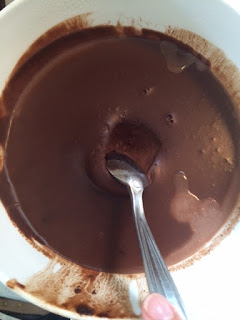I hear that sentiment all the time. And my response? "If you don't like tofu, you're not making it right!" And yes, just because you ordered it from a restaurant does NOT mean that it was made right and that's how it's supposed to taste like. Some people like to just eat tofu no matter which way its prepared. But not me. I've spit tofu out and refused to eat it. It makes sense though. Most people don't just take beef, chicken, or fish and throw it in the oven or on the stove to cook without taking the time to prepare, tenderize, and season it before cooking. So why wouldn't you take the same time to prepare the tofu before cooking it?
Having a husband that is a definite meat-eater...I was pleasantly surprised to know that he loves when I make tofu. It's easier to make one protein option for the both of us, which can be difficult with a vegetarian-carnivore couple! So I thought that I would share my way of preparing tofu so that maybe you guys at home can see whether or not your family likes it too. Granted, take into consideration that even if it is prepared right it may not be something that delights your taste buds. But you might as well try it! The great thing about tofu is that it is so versatile. It will soak up whatever flavor you are cooking. For example, are you making Asian food? Well, your teriyaki tofu will be a great replacement to chicken. Barbecuing this weekend? Well, bite into a delicious BBQ tofu dish! Going Italian instead? Let the flavors of Italy dance on your palate from your tofu. Get the point? But if you miss the first two steps you will miss the mark COMPLETELY!! So go on and read what I do to prepare my tofu.
FIRST STEP:
1. BUY THE CORRECT TOFU!
You can buy different types of tofu and each of those are used for differing recipes. These can be purchased at WalMart, Earthfare, and Whole Foods. Unfortunately Aldi's and Giant Eagle do not sell blocks of tofu. They only sell soy-based foods like soy burgers, etc. Of course, Giant Eagle will give you more soy options like breakfast sandwiches, ribs, burgers, crumbles for stews or sauces, and hot dogs. Regular tofu has soft, medium, firm, and extra firm options. These describe the sturdiness of the tofu block. This is usually the brand and consistency that I buy.
For example, the soft tofu will crumble very easily compared to the extra firm option. Soft tofu is best for putting into smoothies/shakes, tofu scrambles instead of eggs for protein, or casseroles. I also buy the extra firm tofu because I personally like to be able to cut the tofu into either squares, triangles, slices, etc depending on my need. Besides regular tofu, you can buy silken tofu. I do not like silken tofu at all and therefore don't deal with it really at all. I do not prefer the slimy, slick consistency of the silken tofu. So it could be possible that one of the reasons that you didn't like the tofu was because silken tofu was used instead of regular tofu. Regular tofu has more of a meat-type consistency to it. So this first step could make or break your recipe. If you don't like one type of tofu, try another. For example, if you don't like Salmon you might try Tilapia. They are both fish, but have different tastes and consistencies. All tofu is not created equal, just like all meat is not created equally.
SECOND STEP:
2. DRAIN YOUR TOFU!
As I mentioned before, I always purchase the extra firm tofu so that it was actually keep its shape when I work with it. When you buy the tofu cut open the package and drain the juices.
(The package of tofu will contain juices in it to preserve the quality of the tofu. Drain out the juices and the following picture is what you are left with.)
If you are not going to use the entire block at once, you can keep it in the fridge. But make sure to put some water in the container. It'll keep for a few days. I usually use the entire block because I make several days of lunches or dinner for two. Now that you have the block of tofu out of the container, you HAVE to drain it further. Like I mentioned before the tofu will soak up any flavor you are cooking with. But it cannot do that if the juice that was in the package is still in the tofu. Think of the block of tofu like a sponge. I cut the tofu into slices and line them up on a clean kitchen towel.
(Tofu already drained)
You can use paper towels but you will end up using a LOT of towels, so it is cheaper to use a real towel. I line up the tofu and roll it up in the towel. Carefully press down on the tofu and you will feel the towel soaking up the juice that was once in the tofu. If you have bought the extra firm tofu it will keep it shape even with the applied gentle pressure used to drain the tofu. Unroll the towel to expose your tofu slices. You can see in the picture above the towel has soaked up the rest of the juice within the tofu.
THIRD STEP:
3. Cut the tofu!
I cut the tofu dependent on what I am using the tofu for. I'll use cubes for wraps or just to eat, larger slices for burgers or sandwiches. etc. But usually I cut the tofu into cubes.
FOURTH STEP:
4. COOK IT!
After the tofu has been drained and cut, I cook the tofu. I add some olive oil or Pam spray to the pan and throw the tofu in when it gets hot.
I usually cook the tofu longer then some may because I like the crispiness of it. Cook the tofu and consistently flip them over or they will burn only on one side. Once the tofu starts to get crispy I will season it.
You can season it before hand or marinate it, but I just season it as I cook it. If I am looking for a BBQ tofu I simply put some of my favorite BBQ sauce in the pan and let the tofu soak it up.
You may want to try cooking it different ways to see which way you like it best. But our family likes its crispy! You can also cook the tofu on the grill if you put down aluminum foil (so it doesn't fall through the cracks) and oil the foil before cooking.
FIFTH STEP:
5. ENJOY!
The next step is my favorite! Just enjoy your tofu as a family! You can even include this tofu in a casserole in order to hide it better so your family wont notice. But as for our family we just have it as a side of protein!






















.JPG)
.JPG)
.JPG)

.JPG)

.JPG)

.JPG)
.JPG)
 (Maria Rodale)
(Maria Rodale)




.JPG)
.JPG)
.JPG)
.JPG)
.JPG)
.JPG)
.JPG)
.JPG)
.JPG)